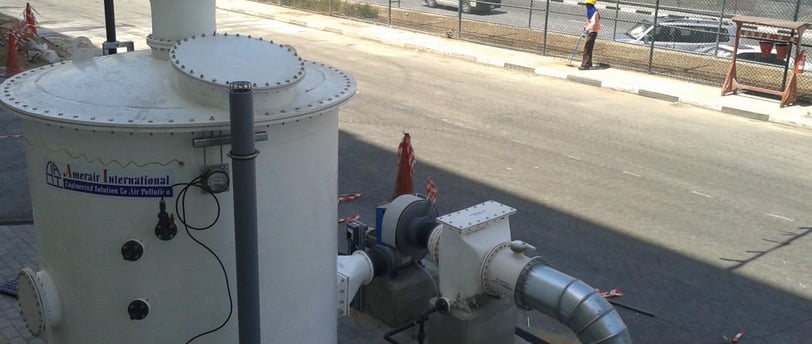Managing Sewer Pump Station Fumes with Carbon Filters and Breakthrough H2S Meters
Sewer pump stations are critical infrastructure for managing wastewater, but they often produce noxious fumes, particularly hydrogen sulfide (H2S), which is notorious for its rotten egg odor and potential health hazards. Effective odor control is essential to ensure community well-being and compliance with environmental regulations. One of the most reliable solutions for managing these fumes is the use of activated carbon filters, coupled with breakthrough H2S meters to monitor filter performance and confirm exhaustion. This blog post explores how these technologies work together to mitigate sewer pump station odors efficiently and reliably.
WASTEWATER
5/22/20254 min read


Sewer pump stations are critical infrastructure for managing wastewater, but they often produce noxious fumes, particularly hydrogen sulfide (H2S), which is notorious for its rotten egg odor and potential health hazards. Effective odor control is essential to ensure community well-being and compliance with environmental regulations. One of the most reliable solutions for managing these fumes is the use of activated carbon filters, coupled with breakthrough H2S meters to monitor filter performance and confirm exhaustion. This blog post explores how these technologies work together to mitigate sewer pump station odors efficiently and reliably.
The Challenge of Sewer Pump Station Fumes
Sewer pump stations, also known as lift stations, facilitate the transport of wastewater through sewer systems. However, the anaerobic decomposition of organic matter in wastewater generates gases like H2S, ammonia, carbon dioxide, and volatile organic compounds (VOCs). H2S is particularly problematic due to its strong odor, corrosiveness, and toxicity at high concentrations. According to regulatory guidelines, H2S levels in wastewater systems should typically be kept below 5–10 parts per million (ppm) to minimize odor complaints and health risks.
Traditional odor control methods, such as chemical dosing with iron salts or air scrubbers, can be effective but often require significant maintenance or fail to address all odor-causing compounds. Activated carbon filters offer a robust, low-maintenance solution for capturing H2S and other odorous gases, while breakthrough H2S meters ensure timely filter replacement to maintain performance.
How Activated Carbon Filters Work
Activated carbon filters are widely used in sewer pump stations to remove odorous gases from the air before they are released into the environment. These filters contain granular or pelletized activated carbon, a highly porous material with a large surface area that adsorbs gaseous contaminants. Specialized products, such as Darco H2S catalytic activated carbon, are designed specifically to target H2S and sulfur compounds, converting them into less harmful substances through catalytic reactions.
In a typical setup:
Air Extraction: Odorous air from the pump station, wet well, or lift station is vented through a duct system to the carbon filter.
Adsorption: As air passes through the filter, H2S and other gases are adsorbed onto the carbon’s surface, effectively removing them from the airstream.
Clean Air Release: The treated air is released, significantly reducing odor emissions.
Activated carbon filters are particularly effective for low to moderate H2S concentrations (1–2 ppm), though impregnated or catalytic carbons can handle higher levels. These systems are compact, easy to install, and require minimal maintenance, making them ideal for both urban and remote pump stations.
The Role of Breakthrough H2S Meters
While activated carbon filters are highly effective, they have a finite capacity to adsorb H2S. Over time, the carbon becomes saturated, leading to odor breakthrough, where untreated gases pass through the filter, causing renewed odor complaints. To prevent this, breakthrough H2S meters are used to monitor filter performance and confirm when the carbon is exhausted.
A breakthrough H2S meter, such as the Hydrogen Sulfide Breakthrough Indicator by Chemteq, is a device installed downstream of the carbon filter. It continuously measures H2S concentrations in the treated air, detecting when levels exceed a predefined threshold (e.g., 1–5 ppm). These meters are often waterproof, have high sensitivity, and provide real-time data, allowing operators to replace filters before breakthrough occurs. Some systems, like those required by Unitywater, mandate H2S monitoring for all activated carbon units at pump stations with significant carbon beds.
How Breakthrough H2S Meters Work:
Continuous Monitoring: The meter samples air exiting the carbon filter, measuring H2S concentrations at regular intervals (e.g., every 1–5 minutes).
Breakthrough Detection: When H2S levels rise above acceptable limits, the meter signals that the filter is nearing or has reached exhaustion.
Operator Notification: Alerts are sent to operators, often via automated systems, prompting timely filter replacement.
This proactive approach ensures uninterrupted odor control and prevents community complaints or regulatory violations.
Combining activated carbon filters with breakthrough H2S meters offers several advantages for managing sewer pump station fumes:
Effective Odor Control: Carbon filters can reduce H2S concentrations by up to 90%, significantly improving air quality.
Real-Time Monitoring: Breakthrough H2S meters provide continuous data, ensuring filters are replaced before odors escape.
Cost Efficiency: By confirming filter exhaustion, meters prevent premature replacement, optimizing carbon usage and reducing costs.
Regulatory Compliance: Maintaining H2S levels below 5–10 ppm aligns with environmental standards, avoiding fines and public health risks.
Low Maintenance: Carbon filters require minimal upkeep, and H2S meters automate performance monitoring, reducing labor demands.
Challenges and Considerations
While this approach is highly effective, there are some challenges to consider:
Premature Breakthrough: High H2S concentrations or other contaminants (e.g., VOCs) can saturate filters faster than expected, necessitating careful monitoring.
Non-H2S Odors: Carbon filters may not fully address other odorants, such as mercaptans or ammonia, requiring additional treatment in some cases.
Cost of Specialized Carbon: Catalytic or impregnated carbons, like Darco H2S, can be more expensive than standard carbon, though their higher capacity often justifies the cost.
To mitigate these challenges, operators should select carbon filters designed for their specific H2S load and pair them with reliable H2S meters. Regular maintenance checks and calibration of the meters are also essential to ensure accuracy.
Other methods, such as chemical dosing (e.g., iron salts) or biofilters, are also used for sewer odor control. However:
Chemical Dosing: While effective at reducing H2S formation in wastewater, it requires continuous chemical supply and handling, increasing operational complexity.
Biofilters: These use microorganisms to degrade odors but require more space and maintenance than carbon filters.
Carbon Filters with H2S Meters: Offer a balance of simplicity, effectiveness, and real-time monitoring, making them ideal for pump stations where space and labor are limited.
Case Studies and Real-World Applications
Organizations like Sydney Water have implemented advanced testing rigs to measure the H2S breakthrough capacity of activated carbon, optimizing filter performance. Similarly, LA Sanitation has reported up to 90% H2S reduction in treated sewers using a combination of carbon filters and chemical treatments. These examples demonstrate the reliability of carbon filters when paired with monitoring tools like H2S meters.
Managing sewer pump station fumes is a critical task for protecting communities and complying with environmental regulations. Activated carbon filters, particularly those designed for H2S removal, offer a proven, low-maintenance solution for odor control. By integrating breakthrough H2S meters, operators can monitor filter performance in real-time, ensuring timely replacement and preventing odor breakthrough. This combination delivers reliable, cost-effective, and compliant odor management, making it an ideal choice for modern wastewater systems.
